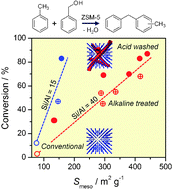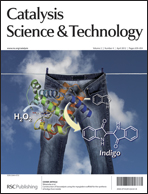Decoupling porosity and compositional effects on desilicated ZSM-5 zeolites for optimal alkylation performance
Abstract
Desilication of conventional zeolites in alkaline medium generates variable intracrystalline mesoporosity, but inevitably changes other properties such as the Si/Al ratio and aluminium distribution. Assessing the individual effects of porosity and composition on the catalytic performance of desilicated zeolites is relevant for their optimal design. Herein, we decouple the respective impacts in the acid-catalysed alkylation of toluene (or cyclohexylbenzene) with benzyl alcohol. These reactions experience strong accessibility constraints to the micropores, providing high sensitivity to the properties of the developed mesopore surface. Through strategic comparison of alkaline-treated ZSM-5 zeolites prepared with and without subsequent acid treatment, we show that while acidity is important, the alkylation activity is dominated by the mesoporous surface area. The selectivity to (methylbenzyl)benzene does not depend on the available external surface. Excessively large mesopore volumes are detrimental to the activity, and variation in micropore volume has a minimal effect. Acid-treated mesoporous zeolites exhibit higher catalytic activities primarily due to textural enhancements by removal of aluminium-rich amorphous debris. The catalytic results are rationalised on the basis of extensive characterisation (AAS, N2 sorption, XRD, TEM, 27Al MAS NMR, FTIR, NH3-TPD, and adsorption of toluene and cyclohexylbenzene).


 Please wait while we load your content...
Please wait while we load your content...